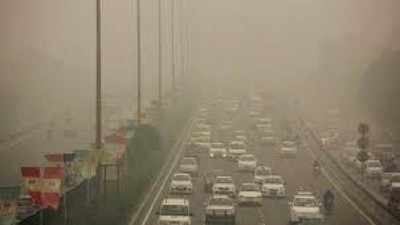- News
- City News
- delhi News
- Dwarka hits 'severe' mark as Delhi air quality continues to deteriorate
Trending
This story is from October 16, 2019
Dwarka hits 'severe' mark as Delhi air quality continues to deteriorate
Even as agencies intensified anti-pollution measures under the Graded Response Action Plan, Delhi's air quality on Tuesday slipped further. While the average AQI was 272, Dwarka sector 8 hit the "severe" mark by 9pm, with a 480 reading.

NEW DELHI: Even as agencies intensified anti-pollution measures under the Graded Response Action Plan, Delhi's air quality on Tuesday slipped further. While the average AQI was 272, Dwarka sector 8 hit the "severe" mark by 9pm, with a 480 reading.
Delhi Technological University wasn't far behind with an AQI of 394, followed closely by Sirifort (387). Rohini (348) and Nehru Nagar (332) also got the first glimpse of things in store this winter.Delhi's neighbours, Ghaziabad (322) and Noida Sector 62 (326), grappled with bad air too. Gurugram was comparatively better off with an AQI of 326. Though stubble burning incidents went up marginally in Punjab and Haryana, scientists reiterated that their impact on Delhi's air quality wasn't stark, as of now.
Track the pollution level in your city
 An NCR-wide ban on generators came into force as a part of GRAP. This is the first time that such a ban has been extended to Gurugram, Ghaziabad, Noida, Greater Noida, Faridabad, Sonipat, Panipat and Bahadurgarh.
An NCR-wide ban on generators came into force as a part of GRAP. This is the first time that such a ban has been extended to Gurugram, Ghaziabad, Noida, Greater Noida, Faridabad, Sonipat, Panipat and Bahadurgarh.
It added: "Surface winds are slow and variable and the wind direction is south-southwesterly, which is not quite favourable for efficient transport of fire plumes towards Delhi. In this condition, drastic deterioration of air quality is not expected over the next two days." It predicted that AQI will fluctuate between the higher end of "poor" category and the lower end of "very poor" category.
The India Meteorological Department said the air quality was likely to improve due to changing weather conditions. "A fresh western disturbance is likely to impact the western Himalayan region from October 18. It is likely to enhance the wind speed, which will help disperse pollutants," said a senior IMD official.
SAFAR observed that stubble burning in Haryana, Punjab and nearby border regions had shown an increasing trend over the last 24 hours. Data showed that the share of stubble burning in PM2.5 concentration was 5% on Tuesday. It is predicted to increase to 6% on Wednesday.
Delhi Technological University wasn't far behind with an AQI of 394, followed closely by Sirifort (387). Rohini (348) and Nehru Nagar (332) also got the first glimpse of things in store this winter.Delhi's neighbours, Ghaziabad (322) and Noida Sector 62 (326), grappled with bad air too. Gurugram was comparatively better off with an AQI of 326. Though stubble burning incidents went up marginally in Punjab and Haryana, scientists reiterated that their impact on Delhi's air quality wasn't stark, as of now.
Track the pollution level in your city

A report by System of Air Quality and Weather Forecasting and Research (SAFAR), a body under Union ministry of earth sciences, said: "Delhi's overall air quality is at the higher end of poor category. It touched the very poor category for a brief period on Monday night."
It added: "Surface winds are slow and variable and the wind direction is south-southwesterly, which is not quite favourable for efficient transport of fire plumes towards Delhi. In this condition, drastic deterioration of air quality is not expected over the next two days." It predicted that AQI will fluctuate between the higher end of "poor" category and the lower end of "very poor" category.
The India Meteorological Department said the air quality was likely to improve due to changing weather conditions. "A fresh western disturbance is likely to impact the western Himalayan region from October 18. It is likely to enhance the wind speed, which will help disperse pollutants," said a senior IMD official.
SAFAR observed that stubble burning in Haryana, Punjab and nearby border regions had shown an increasing trend over the last 24 hours. Data showed that the share of stubble burning in PM2.5 concentration was 5% on Tuesday. It is predicted to increase to 6% on Wednesday.
End of Article
FOLLOW US ON SOCIAL MEDIA










